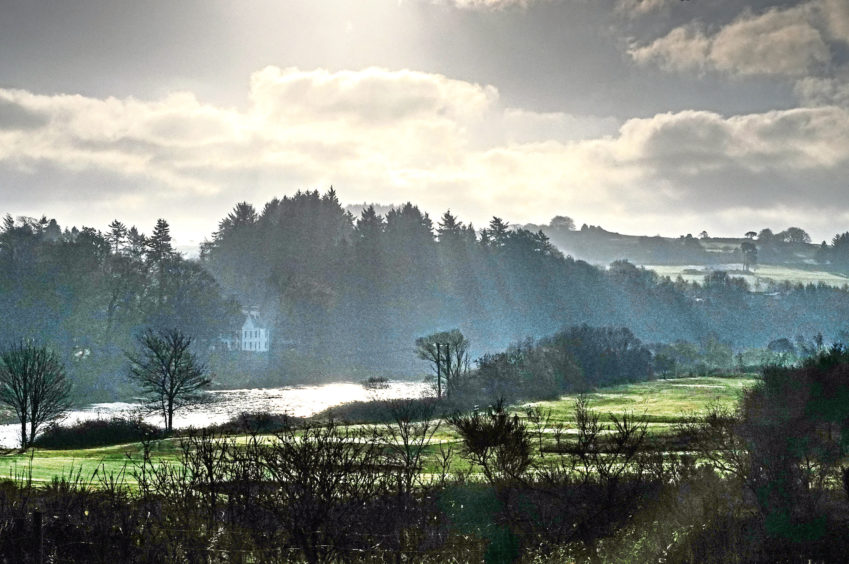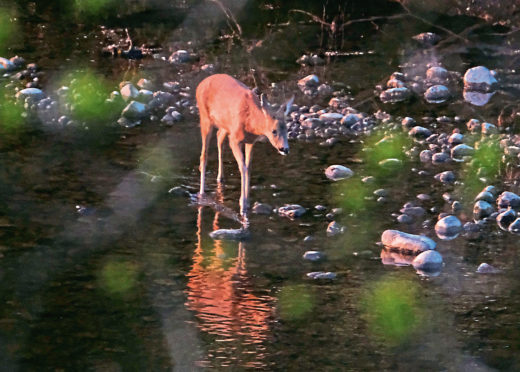This walk starts from the heritage centre car park next to the old Culter station platform on the Deeside Way.
From here on, the path is partially tarmac and the rest is gravel and stones.
A great deal of work has been done by local volunteers, including some contractors, to restore the path to a reasonable state over the last year. The surface degrades with the winter weather and occasional floods, so ongoing maintenance is necessary.
As you walk, the path runs beside the Heritage Hall down through a passageway, opening out on to the river bend with Maryculter House Hotel and Peterculter Golf Club both visible to the right.
This is one of the most beautiful stretches of the Dee, with a usually serene atmosphere regardless of season. There is often visible wildlife, particularly at the extremes of daylight, when young deer and occasionally otters frequent the banks. Stately herons and crested mergansers are usually around too. There are a number of benches and seats suitable for peaceful contemplation of the river.
On the other side of the river, the Peterculter Scout Troop have a hut which they use in the summer. At the far end, the path skirts Camphill School and turns round to the left into Pittengullies Brae. The road crosses the Deeside Way, which will take you back to the station as the track winds on the old railway track, far above the river.
As a photographer, I love this stretch of river. In winter, the majestic beeches on the far bank are often silhouetted against a blue sky. The shapes of the trees are highlighted by the quality of winter light. Shadows are pronounced, and on a windless day the reflections in the river are often striking.

In winter, the dead leaves paint the paths a deep brown. When it freezes, there are often patches of floating slush in the river, which the fishermen call “grue”. This makes a constant swishing sound which to me sounds like background whispering. Sometimes ice accumulates around tree branches dipping in the river – very photogenic.
However, on a sunny day here, the high level of contrast poses a challenge to the photographer. Do you expose for the shadows and “white out” the light areas, or do you expose for the highlights and plunge everything else into darkness? The human eye has much more latitude than even the best chip or film.
It’s best to turn the problem into an asset. Look for patterns and shapes that emphasise the contrasting light. Shoot in black and white if you want to simplify your composition. Alternatively, avail yourself of a bracket setting, if your camera has one, to shoot several images at different exposures one after the other. Most digital cameras above the smallest compacts will do this.
Set the interval between the exposures to one “stop” and take three in quick succession. Using a piece of editing software (Photomatix is a good one to start with and is downloadable from the internet), you can blend the images together so that both the highlights and the shadows will be rendered accurately. The software is clever enough to make an exact match so you don’t need a tripod to do this – providing you keep the camera steady.
Some cameras and even smartphones have what they call an HDR setting, which stands for High Dynamic Range. This is the same idea, as the phone camera combines images to get more range. You have a lot more control if you do it manually, however. In the film era, neutral density filters were used to reduce the highlights and strengthen shadow detail. You can still play with these on certain digital cameras if you have a filter holder.
Overall, however, make use of what the scene offers you. Use reflections if there are any or shoot more abstract pictures to emphasise shapes. Don’t be afraid to play, as with a digital camera it costs nothing other than your time.
Lover’s Walk on a bright day is a perfect place to absorb the tranquillity and shed your worries. Hopefully you might even get a few nice shots at the same time.
The route
- Location: Lover’s Walk, Peterculter, Aberdeen
- Distance: 1.5 miles
- Time: One hour – allowing plenty time to photograph
- Condition: Good – stout shoes or boots if it has been wet or icy
- Difficulty: Easy
